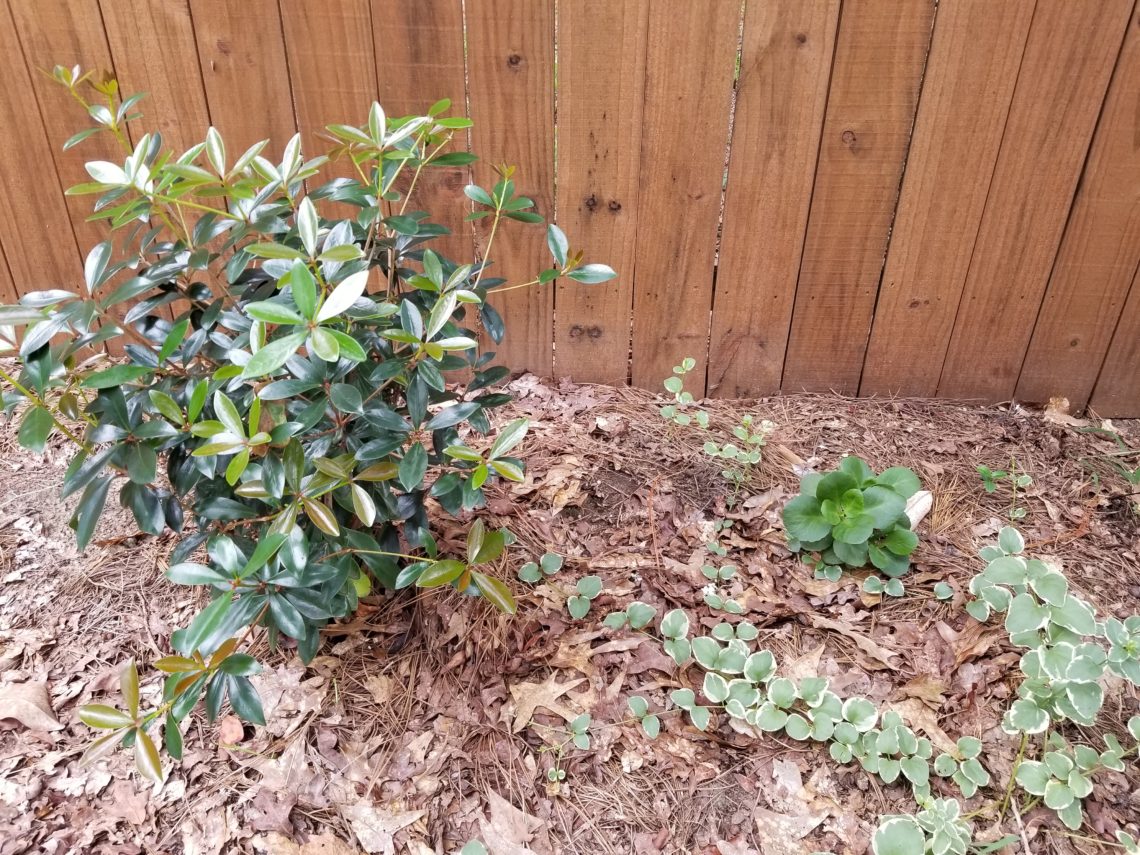
3 Lessons from a Recovering Perfectionist’s Attempt at Landscaping
Here’s a piece of my journey in overcoming perfectionism in nature, marked by laying down the shovel and learning to be patient with my slow-growing shrubs 🙂
Rearing-perfectionism and my first house
My husband and I bought our first house in our early 20’s. Looking back, we had no idea what we were really getting ourselves into at the time, but we enjoyed the idea of having something of our own. It was special, and freeing to do what we wanted, without the limits or restrictions of renting.
It didn’t take long, however, for my perfectionism to rear its head with its own wants and desires for the home. I recognize that many first-time home buyers may get caught up in this same cycle, trying to find the best kitchen outline, the best color for the master bedroom, or the best spot for the china cabinet. Sure, all these thoughts ran through my head, but instead of turning towards interior decorating or pintrest-perfect renovations, my perfectionism truly flared in the vicious world of landscaping.
I initially thought about hiring someone else do to the job, but was too stingy and broke at the time to really consider it. After all, how hard could it be to pull up some weeds, whack out old brush, and create a glorious scenery filled with flowering shrubs and trees, all balanced and aligned with the unique structure and features of our home?
If you’ve ever dabbled in the world of landscaping, I bet you just had yourself a good chuckle. For this is no easy task, especially for an indecisive 20 something who can’t figure out what to cook for breakfast some days. And for those of you who share in the burdens of perfectionism, you’ll especially acknowledge the struggle of this endeavor, I’m sure.
Here, I’ll share what I learned through my attempts at landscaping—not necessarily about landscaping itself —but where the twisted weeds of perfectionism can lead you, if you don’t learn to pull them up sooner.
Overcoming Perfectionism in Nature
1. Striving for perfection = endless exhaustion
My landscaping journey started as I sporadically started pulling up old brush and bushes from before. Instead of going with what was already there, I decided to start from scratch. Again, “how hard could it be?” I thought.
I asked my neighbor for feedback on a good variety of shrubs to plant alongside my long privacy fence that ran by the road. He recommended a few Cleyera bushes, as they were simple, easy to grow, and tolerated the tortuous sun of South Carolina somewhat well.
This neighbor of mine, he had that kind of yard that always pulled in glances and pointed fingers from afar. His flowers, shrubs, and everything in between were positioned so beautifully and complimented the larger landscaping scene so well. You could tell he knew what he was doing, so I listened, and purchased my first few Cleyera bushes from Lowe’s and staggered them alongside my fence. I threw in a few perennials and tried my hand at a few wildflower seeds. I then stepped back to watch things grow.
Except they didn’t, and I couldn’t.
After a few months in, I noticed that some of my Cleyera bushes weren’t growing right, perhaps because of the limited sun blocked by overhanging trees. My seeds weren’t springing up, likely due to the intense summer heat and sandy soil. Some sort of vicious pest started munching on my perennials, leaving me only a few flowers here and there. I started seeing other areas of the yard that desperately needed attention, and I started frantically thinking through what to do with all that restless space.
Irritability and restlessness set in, and I became determined to make things right. I hurried off to Lowe’s, purchased a few more fancy tools and potted plants, and started rearranging my outline. Yes, rearranging. In the dead heat of the summer, I started pulling up previously established Cleyera bushes and replanting them in places with more sun. I had no idea what I was really doing; all I knew was that they weren’t growing well and they didn’t look right. And that, of course, needed to be fixed.
And the sad part is, I didn’t just do this sort of thing once during my landscaping fiasco; I did it multiple times, to a few different bushes and shrubs over the course of about a year. I contemplated their positions based on the amount of sun they might get, the way the water would hit the roots after running off the roof, or how they might appear to a morning walker gazing into my yard. Anytime I felt like something was off, or wrong, I made a decision to dig up the shrub and move it to a different place in the ground. I wasn’t happy until it felt right.
Thus began a vicious cycle, for I kept entertaining new places where the bushes might fit in or bloom a bit better, based on pictures I’d see in Southern Living magazines or from my saved landscaping Pintrest pins.
As you can imagine, I never reached a place where everything felt or looked just as I wanted. Perfection was unattainable in my shrub-coordinating efforts; for there was never an end to the “what-if’s” or “could-be’s” when thinking through new positions or placements for both my newly purchased, and almost dead, plants that filled the empty spaces of my yard. All it did, aside from the extra sunburns and sore muscles, was lead me to a place of exhaustion and a desire to give up on landscaping altogether. In our efforts of overcoming perfectionism, we must recognize that perfectionism itself is unattainable, and often only leads us to places of unrest and dissatisfaction.
2. Striving for perfection may hinder the natural progression of life
When you look at nature (true nature in its wildest form) there is no perfect symmetry or order. Trees lean at odd angles and carry uneven branches. Grass grows at different speeds, and weeds could care less where they take root.
Nature itself exists, just as it is. It doesn’t try to be something it is not. Us humans, we are the ones who come along and prune, cut, and spray our insecticides on life that is already thriving in its natural state.
In my attempts to “create” an ideal landscape, I reverted to pulling up well established roots, over and over again, pruning branches that provided much needed support, and over-watering seeds that ended up drowning in overly fertilized soil. Can you guess what happened? I had nothing to show for it in the end. Only frail, wilted shrubs and scorched seedlings that caterpillars and rodents ended up devouring in the end.
Sure, I’m speaking about plants here, but isn’t this how it is with life? How often, in our attempts to control, do we make things worse off in the end?
Instead, the best products develop when we stop idealizing our outcomes. The best decisions arise when we first let go of the pressure to decide. We enjoy life most when we lay down our expectations of what should or shouldn’t happen. Shrubs and seedlings thrive when they are given the right care, freedom, and time to do so. Not when they are pulled up, second-guessed, or over-analyzed. So it is with us.
3. We miss out on what could have been, when we blindly pursue what should have been
After about a year of planting and re-planting, re-arranging and re-potting, I recognized that I was the one responsible for stunting my plants’ growth (rather than those frustrating places of partial shade or annoying aphids as I had once thought). In response, I often found myself walking around my neighborhood staring enviously at others’ flourishing gardens and green, luscious shrubs. I became annoyed, irritated, and frustrated with myself for letting perfectionism take over. I started picturing what my landscaping job might have grown into if I had not intervened as vigorously or stubbornly as I did.
I soon began to wish that I had just let things be. For all the time and energy I spent thinking through new set-ups or placements of my raised beds was largely wasted. In my attempts to create something perfect, I missed out on the beauty and uniqueness of what could have been.
In The Gifts of Imperfection, Brené Brown encourages us to let go of who the culture or society says we should be and embrace those imperfect, unique qualities that make us who we are. She states:
“When we spend a lifetime trying to distance ourselves from the parts of our lives that don’t fit with who we think we’re supposed to be, we stand outside of our story and hustle for our worthiness by constantly performing, perfecting, pleasing, and proving. Our sense of worthiness—that critically important piece that gives us access to love and belonging—lives inside of our story.”
When we try to hide behind or fiercely pursue a “perfected” story or image (or a highly-manicured landscaping job) we miss out on the beauty and freedom that comes with just being ourselves. Sometimes, its OK to let our leaves fall, and our grass to stay uncut. Its OK to show ourselves to the world, and stop pursuing who we’re told we should be.
I’ve since learned to smile at my slow growing shrubs and bushes, and cherish my late blooming flowers. I cherish the lessons learned through all the extra sweat, dirt, and digging from my former landscaping days. And now, on my evening walks, I’ve also learned to pay closer attention to those gardens without perfect symmetry or order, and to appreciate those lawns with patches of missing grass. For here, I see and celebrate genuine authenticity in its greenish-brown, natural form.




